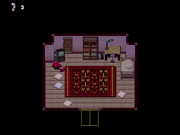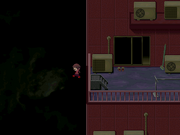
Madotsuki's Room("Early Sunday Morning")

The Wi-wanyang-wa-c'i-pi (Sundance Ceremony)
Madotsuki's Room(Native Americans in the United States)[]
4 宗教 4.7 平原部での宗教 4.7.1 サン・ダンスの儀式
「サン・ダンス(Sun Dance)」とは、スー語の「ウィワンヤンク・ワチピ(太陽を見つめる踊り)」を英訳したものである。
"Sun Dance (Sun Dance)" and is one that was translated into English The "Wi-wanyang-wa-c'i-pi" Sue-language.
平原の部族は、死ねば無条件で「狩猟の楽園」へ行くことができ、このため、今世は楽しみごとに費やすべきだと考えた。
When the tribe of the plain died, it could go to "paradise of hunting" unconditionally, and for this reason, I thought that the world should have been spent for every pleasure now.
ただ、「大自然の力は放置すると衰退する」としてスー族やブラックフット族、シャイアン族、カイオワ族など平原部族の多くは、毎年夏至の頃に、大自然の回復と部族の繁栄を祈祷し、誓いを立てて大精霊に祈りを捧げるこのサン・ダンスの儀式を行う。
However, many of plain tribes, such as the Soe fellows, Blackfoot and the Sheyenne fellows, and Kaiowa fellows, hold the ceremony of this Sundance that prays recovery of Nature, and a tribe's prosperity, stands an oath, and offers a prayer to a large spirit of a departed person every year at the time of the summer solstice as "declining, if the power of Nature is neglected."
※Also of "The KALIMBA TV Channel" and "Sun Dance"
http://yumenikki.wikia.com/wiki/The_KALIMBA_TV_Channel(name)

Navajo's Lag(Madotsuki's Room)
[]
近隣のプエブロ族から採り入れた「地底から先祖が現れた」という神話を持ち、その再現である「イェイビチェイ」と呼ばれる大掛かりな精霊行進の儀式が有名である。ターコイズと銀を用いた宝石細工を得意とし、ナバホのほとんどはこの装飾品を身につけている。「インディアン・フルート」の奏者も多い。

Indian Flute Player(the myth taken in from the neighboring Pueblo "the ancestor appeared from depths of the earth")
The ceremony of the large-scale spirit-of-a-departed-person march which has the myth taken in from the neighboring Pueblo "the ancestor appeared from depths of the earth", and is called "イェイビチェイ?" which is the reappearance is famous.
The jewelry work using turquoise and silver is made elated, and most Navajo puts on these accessories.
There are also many players of an "Indian flute."

"Navajo Lag"(Transition 1880)
「先取の才がある」といわれ、18世紀にスペイン人が羊を持ち込んだ際には、羊の放牧をすぐに採り入れた。「ナバホ・ラグ」と呼ばれる精巧な絵柄の羊毛の敷布は19世紀に貴重な交易品となり、現在も珍重される。母系社会であり、放牧も織物も、現在でも女性の仕事である。
It is said that "there is a preoccupation of old", when the Spaniards brought the sheep in the 18th century, was soon adopted grazing sheep. Fleece bedsheets elaborate pattern called "Navajo Rag" is a valuable trade goods in the 19th century, are still prized. Is a matrilineal society, and also textile grazing, is women's work today.

Red,Purple,Yellow,and Green color books.(Tawa-Kachina color)
Madotsuki's Room(Hopi mythology)[]

"Yellow" and "Red" Head,"Green" Face,"Purple" Eyes and Mouth and Feathers of Eagle.
Most Hopi accounts of creation center around Tawa, the Sun Spirit. Tawa is the Creator, and it was he who formed the First World out of Tokpella, or Endless Space, as well as its original inhabitants.[6] It is still traditional for Hopi mothers to seek a blessing from the Sun for their newborn children.[7] However, other accounts have it that Tawa, or Taiowa, first created Sotuknang, whom he called his nephew.
※The Bookshelf, in Madotsuki's room is an entrance in the world of a dream, That is, the first world(Most Hopi accounts of creation center/formed the First World?)

HOPI SILVER "Sun"
【太陽(Sun)】
万物の創造主。絶対神とも言える存在。厳密に言えば遠い宇宙にいる神が人間の暮らしを見守る(見張る)為の窓が太陽だと言われている。
Creator of all things. I also say that God exists absolutely. For windows (watch) that are in the distant universe God watches over the lives of human beings, strictly speaking, is said to be the sun. http://www.rakuten.ne.jp/gold/peace-clothing/hopisymbol.html

A Luopan, Feng shui compass.
Madotsuki's Room(Feng shui)[]

Nirvana Figure (19th century)
北
睡眠する場合に、北側に頭を向けて寝る事を「北枕」といい、縁起の悪いものとされる。
- 北枕の凶運は、釈迦が死んだ時に、頭を北向きにして安置された事に由来する。
日本では、太陽が南で頂に達する事から、部屋の間取りでは南向きが好まれる。
- 他の国の中には、家具焼けするなどの理由から南向きは敬遠される場合もある。

Kitamakura(North-Pillow), is to head to the north, towards the south foot bed.
North
When sleeping, it is called "north pillow" to turn the head to the north side and to sleep, and it is considered as what has bad luck.
- Bad luck of the north pillow originates in having carried out the head for north and having been installed, when Gautama Buddha dies.
South
Since the sun arrives at the top in the south in Japan, for south is liked on the room arrangement of the room.
- In other countries, for south may be kept at arm's length from the reasons of carrying out a furniture glow.

madotsuki was facing the west from the north, she was left to go over to the other side when you fall off the bed. (Revived from the dead?)
Madotsuki's Room(North-Pillow)[]
仏教の祖である釈迦が入滅の際、北の方角へ頭を置いて横になった“頭北面西”(ずほくめんさい)といわれることから来ている[1]。これは仏教が将来、北方で久住するという考えから“頭北”が生まれたものである。ただし、この説は北伝の大乗仏教のみで後代による解釈でしかない。
Comes from that which is said to be the time of dying, Buddha is the founder of Buddhism was to lie down and put your head in the north direction (re-myeon First) "head north west" [1]. This is what the "head north" from the future thinking, Kusumi Buddhism that was born in the north. However, this theory is only interpreted by the progeny of only Mahayana Buddhism Den north.
日本では釈迦の故事にちなみ、死を忌むことから、北枕は縁起が悪いこととされ、死者の極楽往生を願い遺体を安置する際のみ許されていた。

“頭北面西”(So dead, head north, face is facing west.)
過去には中国でも北枕の風習があったと言われる。但し、それは仏教に根付くものではなく、食中毒などの急死の際に、北枕に寝かせることで生き返ることがあったためである[2]。
Is said that there is a custom of Kitamakura in China in the past. However, because there was not intended to take root in Buddhist that during sudden death, such as food poisoning, revived by Kitamakura it lay in [2].
この中国思想における北枕の思想は古墳時代初期における日本の権力者の間にも伝わったと見られ、畿内・吉備・出雲における古墳被葬者に古代中国の宗教思想である「生者南面、死者北面」が流行したと考えられている[3]。従って、中世とは異なり、受け入れられていた。

Pink&Blue cusion
Madotsuki's Room(Tsukuba shrine)[]
子宝を願う夫婦のための神社やスポットは全国に数多くありますが、茨城県筑波市に伝わる「子宝枕」は、山の神の祠に置いてある枕を借りてくるというちょっと変わった風習です。つくば市吉沼にある「山の神」の祠には数々の枕が奉納されています。
「山の神」の祠の中には、赤もしくは青の枕が奉納されています。子供が欲しい夫婦は、いずれかの枕を借りてくるのです。男児が欲しい場合は青い枕、女児が欲しい場合赤い枕を選びます。この枕を夫婦の枕の間に置いて眠ると子が授かるとされています。
ご利益のおかげで子供が授かった夫婦は、お礼として授かった子供の色(男児は青、女児は赤)の布で枕を作って、借りていた枕と共に祠に返すのがしきたりです。

Boy was born,pillow blue.Girl was born,red pillow makes in return.

Kodakara-makura
In the shrine of the "ball and chain", the pillow of blue is red or dedication. Couple want a child, I have to borrow one of the pillow. If you want a boy I choose red pillow pillow if you want blue, and girls. Have been blessed with a child is placed between the pillow and sleep with a pillow of this couple.
http://www.rinzo2.jp/~njkmmy/w_t-baby/ema_00.html

Blue pillow in the east direction is not.(Boy not born) Pink pillow to the South and Southeast. (Girl born)
Madotsuki's Room(Feng shui)[]
子供がほしいのに、なかなか子宝に恵まれない方は少なくないかと思います。子宝に恵まれずに悩んでいる方のために、ここでは子宝にまつわる風水をいくつか簡単に紹介しましょう。
I think people who want to have children, do not have a healthy baby and not a few quite. For those who are troubled not have a healthy baby, here will be a brief introduction to some of the Feng Shui Kodakara surrounding.
まずは、風水による男の子と女の子の産みわけかたです。
(First of all, for some reason I was a boy and a girl by the sea of Feng Shui. )
寝室で試してください。
Please try in the bedroom.
・枕の向きを南にすると女の子、枕の向きを東にすると男の子が生まれると言われています。
· I have been told boy and girl born and direction to the east, in the south of the pillow and the orientation of the pillow.
・ザクロや桃を東南か南に置いておくと女の子、北か東北に置いておくと男の子が生まれると言われています。
· I have been born and said to the boy and girl leave the Northeast, north or south or southeast and leave the peach and pomegranate.
(Copyright (C) 2008 風水 部屋と間取り All Rights Reserved.)
子宝風水では、重要なポイントがいくつかあります。それは、寝室です。寝室の方位は、家の中心からみて北方位に部屋がおすすめです。
Kodakara Feng Shui, there are a few important points. It is a bedroom. Orientation of the bedroom, the room is recommended to place the center of the house as seen from the north.
ベッドカバーとシーツは、ピンクでもいいのですが、できればオレンジ色がおすすめです。できるだけ、日に当てた物をつかうといいといわれています。
Bedspreads and sheets, but I'd like pink, orange is recommended if possible. I have said good things as much as possible and use, was applied to the Sun.
そして、枕の向きも、子宝風水では重要です。東枕がおすすめですが、東枕は男の子が生まれて、南枕は女の子が生まれるという説もあります。
Then, the orientation of the pillow is important in feng shui Kodakara. It is recommended east pillow, pillow East Some say a boy was born, pillow southern girl is born.
寝室の北側に「ざくろ」か「桃の実」を置くと効果があるといわれています。
It is said to have the effect of placing the "peach" or "pomegranate" on the north side of the bedroom.
(Copyright (C)子宝に恵まれる風水)
The Ending(East of the Sun and West of the Moon)[]

If "Easter", stepping stone should be located on the "East" rather than "West".(Not Easter?)

Madotsuki fell flying to the East.(In Christ's Witch)
※"Sun" sets in the "West" from the "East"
Discard the Easter Egg of Christ, Madotsuki is became a sun is the symbol of the Hopi?
Madotsuki's Room(Hopi mythology)
Flew to the East of the Mall Rooftop, madotsuki because had the Easter Egg yet?

Red wall of a building(Early Sunday Morning is a "Easter"?)
Madotsuki's Room(Edward Hopper)[]
「日曜の早朝」 米国の画家エドワード・ホッパーの絵画(1930) ◆赤い建物の壁が特異な静けさを感じさせる作品;カンバス 油彩 82×102 cm ニューヨーク近代美術館.
Museum of Modern Art, New York Oil on canvas 82 × 102 cm; work "Early Sunday Morning" feel the serenity peculiar red walls of the building (1930) ◆ U.S. painter Edward Hopper painting.

Edward Hopper"Early Sunday Morning"(1930)
Edward Hopper (1882–1967) produced some of the most enduringly popular images in American art. Throughout his career, he created quiet, yet riveting pictures of ordinary people and places, which in his hands became dramatic scenes that express a sense of isolation, anomie, and the bittersweet comfort of being alone. His images of New York diners, movie palaces, apartments, and offices reflect urban life in America between the world wars; his light-filled watercolors of the New England coast and its architecture evoke the austere beauty of the region.
http://www.nga.gov/exhibitions/2007/hopper/timeline/timeline.shtm
